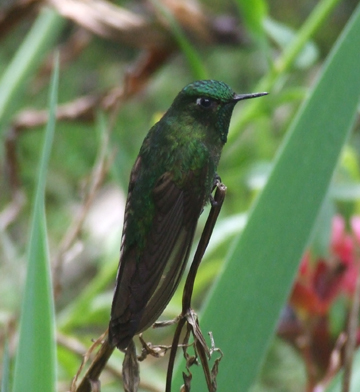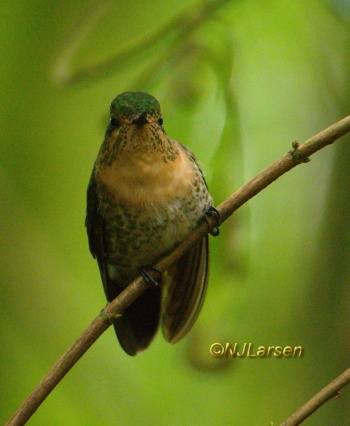- Metallura tyrianthina
Identification
9–10 cm (3½-4 in); straight bill 1 cm.
Male is mainly dark green with glittering green throat gorget and white postocular spot. The subspecies differ in tail coloration, from bronzy-green, bronzy-olive, coppery-red, to golden-red.
Female is slightly smaller than male, green above, buff to cinnamon underside, and with tail similar to male.
Distribution
South America: found in Venezuela, Colombia, Ecuador, Peru, and Bolivia.
Taxonomy
Subspecies
Seven subspecies are recognized[1]:
- M. t. districta:
- M. t. chloropogon:
- Coastal mountains of northern Venezuela
- M. t. oreopola:
- Andes of western Venezuela (Lara, Trujillo and Mérida)
Metallura tyrianthina tyrianthina/quitensis
- M. t. tyrianthina:
- M. t. quitensis:
- Andes of north-western Ecuador
- M. t. septentrionalis:
- Andes of northern Peru (west of Río Marañón)
- M. t. smaragdinicollis:
- Andes of eastern Peru and northern Bolivia
Habitat
Medium to very high elevation often in forest, edges or around clumps of trees in more open high elevation areas.
Behaviour
Usually defends a feeding area from other hummers, at low to middle height of trees. Often lands on flower to feed.
References
- Clements, J. F., T. S. Schulenberg, M. J. Iliff, D. Roberson, T. A. Fredericks, B. L. Sullivan, and C. L. Wood. 2018. The eBird/Clements checklist of birds of the world: v2018. Downloaded from http://www.birds.cornell.edu/clementschecklist/download/
- Restall et al. 2006. Birds of Northern South America. Yale University Press. ISBN 9780300124156
Recommended Citation
- BirdForum Opus contributors. (2025) Tyrian Metaltail. In: BirdForum, the forum for wild birds and birding. Retrieved 3 May 2025 from https://www.birdforum.net/opus/Tyrian_Metaltail
External Links
GSearch checked for 2020 platform.1






